Utilizing its know-how accumulated over more than 100 years, Uchida Yoko is changing the way we learn through innovation in classroom design and digital transformation implementation.
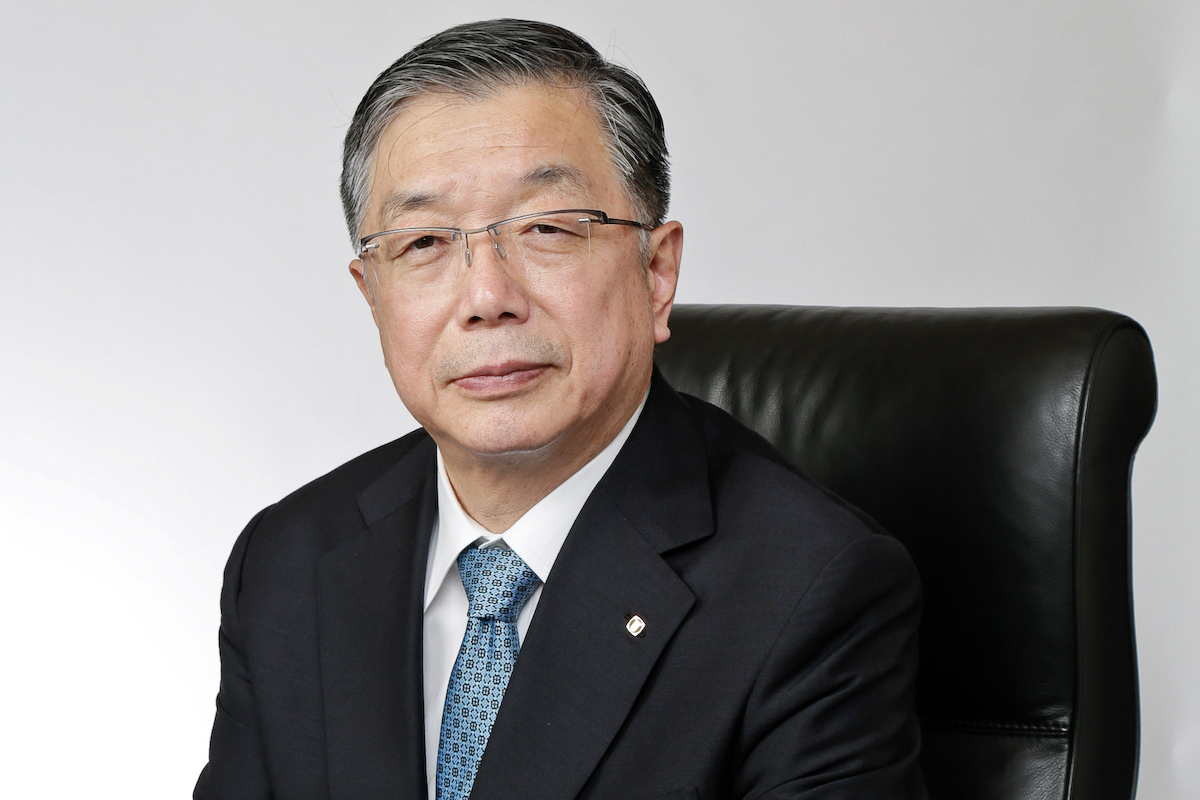
Uchida Yoko has a rich history dating back more than 113 years when it began as a drawing tools firm. Could you highlight some of the most significant milestones in your company’s history that have shaped its values and contributed to the success you see today?
Uchida Yoko was founded in Dalian, China. With its origins in the provision of surveying and drafting equipment, the company grew rapidly and significantly in China and Japan with the development of advanced measuring instruments. The company worked to promote science education in schools, and after World War II, it made a comeback by embarking on new1 businesses.
In 1957, the company signed a sole agency agreement with Casio Computer, which completed the world's first compact relay calculator, the Casio 14-A. In 1963, the company developed and sold its first purely domestic ultra-compact electronic computer, the USAC, and entered the information industry. in the 1980s, when PCs were in their infancy and the Internet did not exist, the company developed its business in the "education" and In the 1980s, when PCs were in their infancy and the Internet did not exist, we took advantage of our expertise in both "education" and "information" to pioneer the informatization of education in schools, and this has become the foundation of our business today.
Our company was one of the first to start a business division system some 60 years ago, and when I joined the company, I was told that it was like having three companies: office-related, public-related, and information-related. After assuming the presidency, we decided to restructure our business to make those three companies and organizations flexible.
Although we are a medium-sized company, we boast a diversified business structure. Conventional wisdom would recommend consolidation or streamlining during difficult times for such a diverse entity, but we pursued our own strategy. We sought to build on the strengths of each business and integrate them in novel and attractive ways, rather than downsize them. This approach has resulted in an integrated entity that has brought these disparate aspects together into a cohesive whole.
We are currently in the process of implementing our 16th Mid-Term Management Plan. We have begun to restructure our business by reviewing the businesses owned by our group from a bird's eye view and classifying them into the environment/space creation -related business and ICT-related business in four matrices, divided into the private market and the public market based on the market axis.
Furthermore, we have stated that we will support our clients' investment in "people" and "data," and the accumulation of data through digitalization and the promotion of change by people are essential for the realization of DX (Digital Trans formation) that is being promoted in the public and private sectors. We will accelerate our support for human resource development and data utilization in line with the times. We have also begun reviewing our organizational structure, and we are aiming to develop new businesses by linking the group through the establishment of a "general manager" to enable cross-sectional customer support. As for the Group's corporate structure, Uchida Esco, which is engaged in the operation and maintenance of help desks and ICT equipment, will be made a wholly owned subsidiary to further accelerate the Uchida Yoko Group's collaboration.
As Uchida Yoko moves forward, how does the company plan to build upon its founding spirit and core values to drive its future direction? Are there any specific areas or initiatives that Uchida Yoko is prioritizing to stay at the forefront of the industry and continue its legacy of success?
As you are undoubtedly aware, Japan is grappling with a substantial demographic decline, particularly pronounced among the youth population. The working-age demographic is also shrinking at an alarming rate, with experts forecasting a significant acceleration starting from 2027. The International Monetary Fund (IMF) has compiled a report named "Shrinkonomics," highlighting how Japan is pioneering lessons in managing aging and diminishing populations. It is important to note that while Japan excels in digitalization, this does not equate to complete digital transformation (DX). Digitalization alone is not synonymous with DX, albeit I acknowledge the intricate nature of achieving true transformation. Despite the challenges Japan faces, I firmly believe the nation possesses significant potential for growth. This has been a stance I have personally advocated since 2015. The imperative lies in revolutionizing our work methods and redefining our approach to learning.
What are your views on the dramatic changes in education that have taken place in Japan with the introduction of 9 million PCs under the measures of the GIGA Schools Initiative in 2019?
Globally, ICT in Japanese schools is currently lagging far behind. The national government has shown a sense of crisis over this situation and has begun to take a serious look at the situation in 2022. The Global Innovation and Gateway for All (GIGA) School Initiative was established. The supplementary budget for FY2021 included 200 billion yen for the "development of in-school communication networks" and the "development of individual devices for each student at national, public, and private elementary, junior high, and special schools. In addition, when emergency economic measures and the Corona Amendment are included, the total budget for the project exceeds 600 billion yen, and local governments operating schools and educational ICT-related companies, including Uchida Yoko, have collaborated to implement 100% of the system nationwide.
In addition to supporting the response to COVID-19, connectivity is envisioned as a means of establishing a solid foundation of hope and opportunity after the pandemic. Currently, the initiative aims to put digital devices in the hands of all of Japan's approximately 13 million elementary and middle school students, with 1 million teachers participating.
Prior to its inception, approximately 1.5 million PCs or tablets were in use. However, this figure has now surpassed 10 million, illustrating the remarkable growth of PC and tablet usage in schools by a staggering 8.5 million units in just two years. To put this into context, the annual number of computing devices sold throughout Japan ranges from 8 to 10 million, comparable to the educational devices introduced into schools nationwide over the past two years. Given the significant government investment in this realm, multiple stakeholders participated. We firmly believe that our contribution has been substantial, particularly in terms of the services we have delivered to the education sector. Our expertise, technology, and ICT knowledge were already extensive and diverse prior to the commencement of the GIGA initiative. This positioned us to play a pivotal role in supporting the implementation of GIGA within the educational landscape.
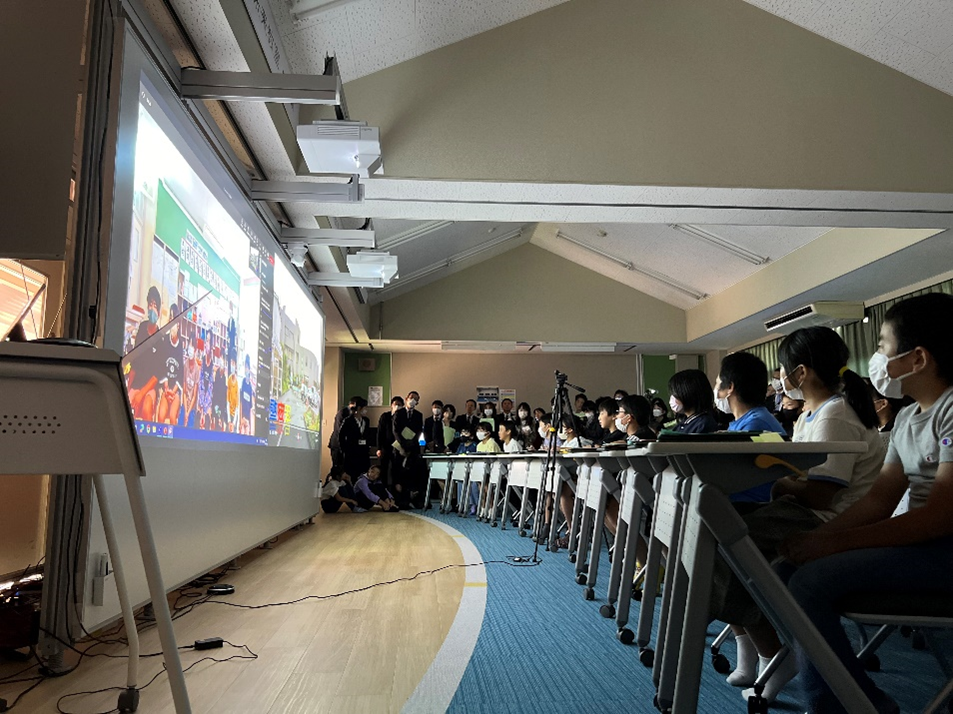
Real-time classroom teaching with remote primary schools.
(Konosu Central Elementary School)
Despite the positive outcomes stemming from GIGA, there were unfortunate challenges pertaining to the stability of school network environments. Presently, the focus has shifted toward establishing secure and reliable networks, a critical necessity in numerous educational institutions. A model exemplifying this approach has been executed in Konosu City. We successfully established a secure network infrastructure in this context, setting a precedent for the potential replication of such services in other regions.
The Board of Education of Konosu City, Saitama Prefecture, is the first board of education in Japan to connect the academic information network SINET and Microsoft Azure, Microsoft's cloud platform, to the full cloud computing platform in 2021, making it the first board of education in Japan to do so. This is a case study that will serve as a national model for other boards of education in Japan. By changing the perimeter defenses that separated the networks for school work, external school work, and learning, and by implementing comprehensive security measures based on a zero-trust model to create a single network, PCs for teachers and staff were integrated. This revolutionary model eliminates the need to separate PCs used in staff rooms, classrooms, and classes into school work, external school work, and learning systems.
The "Konosu Model" has been constructed as a model case for the Ministry of Education, Culture, Sports, Science and Technology's GIGA School Concept.
Konosu City is not only developing a system, but is also making advanced progress in the use of educational data and a curriculum for class reform, and is working on cross-curricular and integrated learning that allows students to use their inquiry-based and autonomous thinking to feel the connections and meanings of the real world. Many boards of education and foreign countries have visited the school, and the school is attracting a great deal of attention as a model municipality nationwide.
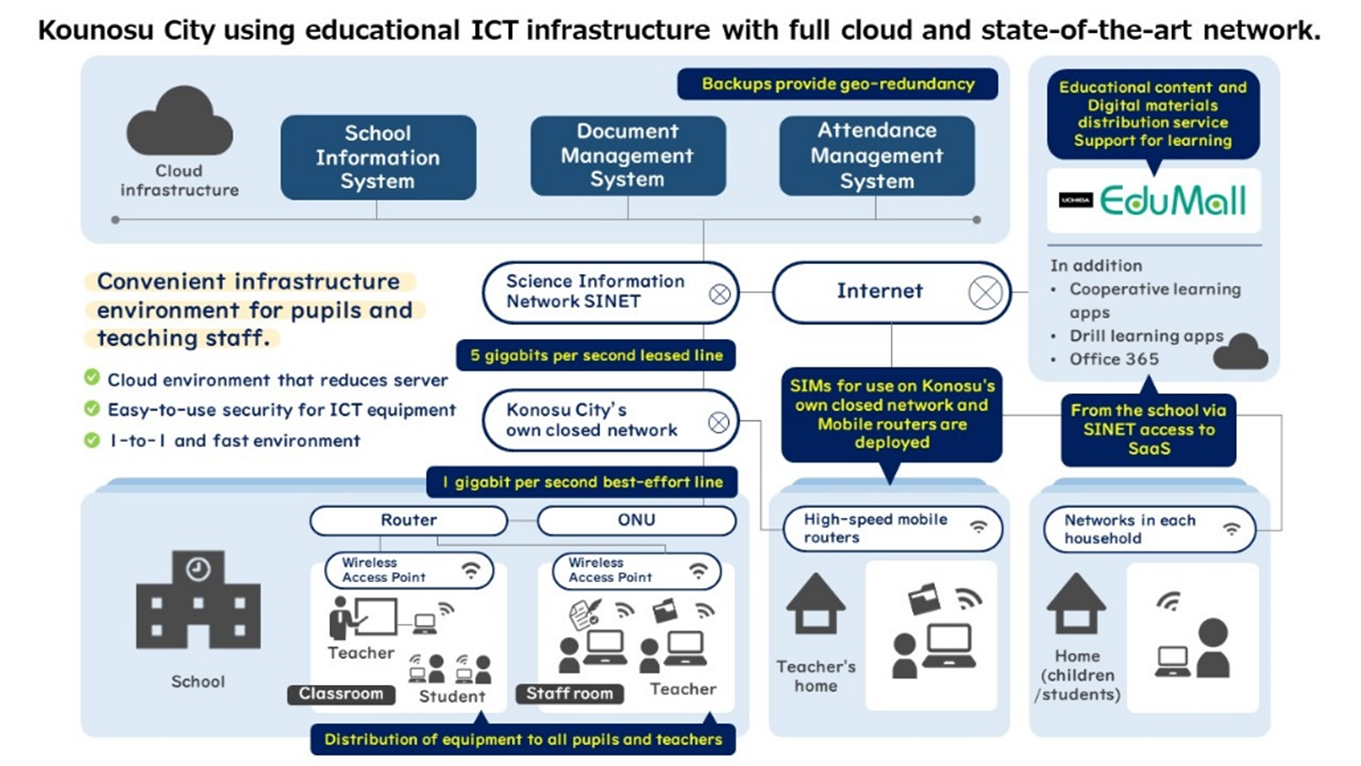
Full-cloud educational ICT environment in Konosu City, Saitama Pref
When utilizing a tablet and a network, the data remains within the network. This paves the way for discussing the MEXT Online Learning System. Notably, MEXT extends beyond this to encompass CBT, which stands for computer-based tests. These tests represent a departure from traditional paper-based tests and introduce an entirely different testing paradigm.
In the past, I spearheaded the "100 Internet Schools" project.
In 1995, I participated in the "100 Schools Project" of the Ministry of International Trade and Industry (MITI). This was Japan's first attempt to connect elementary, junior high, and high schools across the country via the Internet by installing leased lines. Four companies participated in the bidding. At the time, the companies did not know much about Internet construction, and everyone was groping their way through the process. I was confident that the Chubu region, which I was in charge of, was the first to successfully connect to the Internet, ahead of the other regions of major vendors.
In fact, in the third year of the project, the budget stopped and other companies pulled out. However, we could not stop our efforts to promote the informatization of education, and we wanted to conduct new classes using ICT. People from all over the country who have this desire will continue to gather together on a voluntary basis after the project is over, and I will join them in continuing various activities in various locations.
The New Education EXPO has grown to attract more than 10,000 visitors each year in Tokyo and Osaka, and was started by me as a grassroots effort to share the practical knowledge of the 100 Schools Project teachers. The New Education EXPO has become one of the largest school education events in Japan, and will be held for the 29th time in 2024. We will also launch a department that will be the forerunner of the Education Research Institute for the purpose of verifying the results.
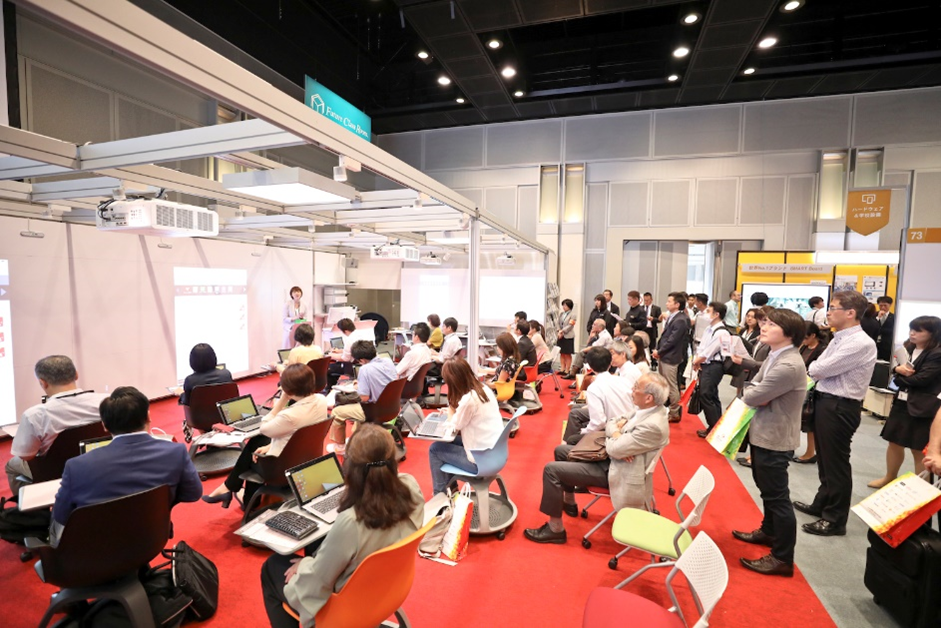
NewEducationEXPO TOKYO
The company has been involved in initiatives related to the evaluation of academic performance using ICT in schools, including participating in the Ministry of Internal Affairs and Communications' Future Schools Promotion Project in 2010 and being commissioned by the Ministry of Education, Culture, Sports, Science and Technology's Innovation in Learning in 2013.
Following the Hundred Schools Project, it was able to participate in a government-led trial focusing on educational content delivery systems.
A further joint project with the government was launched in 2008.The focus was on national achievement test forms. Despite being paper-based, the test employed an alternative scoring mechanism that did not rely on answer sheets. Japan is the only country in the world where more than one million people have participated in the National Achievement Test. In contrast, France and other countries have between 400,000 and 500,000 participants. Therefore, a national A specialised research department on academic achievement tests has been established within the Institute of Education Research.
An important aspect of this initiative was the efficient collection of data and effective scoring within a limited timeframe. Although the data collection was done by computer, the final scoring had to be done by humans.
Under the GIGA School Concept, in addition to the construction of school networks, full cloud computing using cutting-edge technology, and the installation and maintenance of more than 1.4 million PCs and other equipment in municipalities nationwide, we have comprehensively provided many municipalities with digital content and an operation system including ICT support staff and help desks.
The introduction of the devices has led to the start of the use of a system that enables the collection of various data from children and students, and there are moves to utilize the data for education, reform of teachers' work styles, and school management, etc. In the National Survey of Academic Performance and Learning conducted in April 2023, MEXCBT (MEXT's CBT system, which uses computer instead of a paper) was used for English at junior high schools. In order to connect to MEXCBT, we have developed and provided an e-portal for learning called "L-Gate," which has been used by approximately 700 organizations and 9,000 students nationwide. The L-Gate e-portal has been adopted by approximately 700 organizations, 9,000 schools, and 3 million IDs in Japan, and has the largest market share in the country. By analyzing various educational data such as usage history, we expect to be able to optimize the use of study logs for each student and identify potential issues in the future.
On that topic, what opportunities and challenges do you envision coming from the MEXT CBT system?
In GIGA school, Enormous government funding was allocated to develop an expansive infrastructure, enabling all levels of education in Japan, from primary to high school, to leverage online learning systems.
This coincides with the complete acquisition of Luxembourg OAT by Uchida Yoko. Utilizing the resources of Luxembourg OAT, Uchida Yoko was commissioned to develop and build the MEXCBT system, a CBT system for the Ministry of Education, Culture, Sports, Science and Technology.
The National Assessment of Academic Progress in April 2023 will use MEXCBT (MEXT CBT system) for CBT surveys in English at junior high schools.
Notably, Luxembourg OAT offers its services to numerous European countries, including Norway and Italy. Nevertheless, our largest client remains Japan, primarily due to this project's magnitude and significance.
Did you purchase Luxembourg OAT specifically for this project?
Indeed, our acquisition of Luxembourg OAT came afterwards, but the synchronicity is indeed remarkable. I would be delighted to showcase the dashboard we have developed for collating student academic performance data. Our endeavors have focused on crafting software that empowers students to visualize and interact with their academic progress. Currently, we are in the process of deploying this software.
Leading the way is the city of Saitama. Located just north of Tokyo, this city of approximately 1.3 million people is home to more than 160 elementary, junior high, and special-needs schools with a total enrollment of more than 100,000 students. Recognizing the need to change the traditional way schools are run, Saitama City is promoting the groundbreaking Saitama City Smart School Project (SSSP), which aims to utilize digital resources and data to benefit children and teachers.
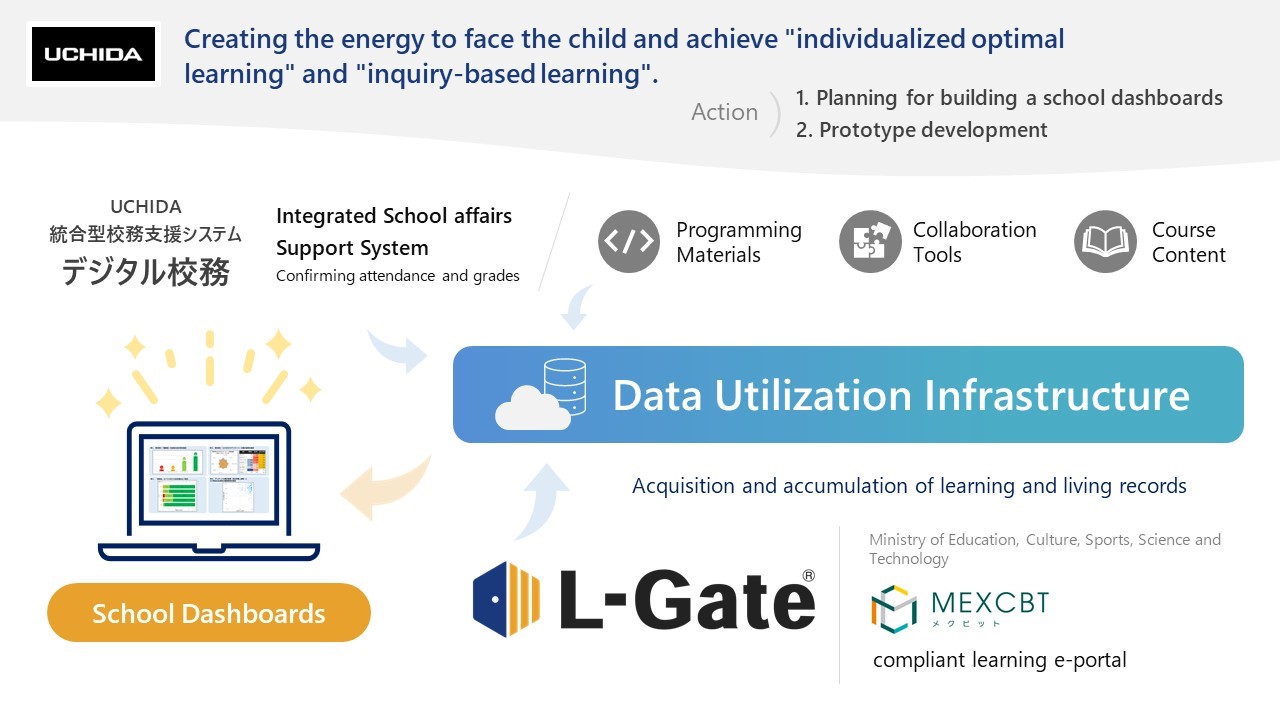
With the implementation of CBT, large-scale data on education is beginning to be gathered, and the focus is on how to make use of this data. We are working on the theme of how to link and make use of data on education obtained at schools and data held by local governments.
Additionally, we have invested in local government initiatives aimed at promoting data integration between schools and local administrations. However, this effort faces challenges in collecting and merging diverse data streams arising from various applications. Moreover, it is important to note that school and government data are distinct entities. Effectively linking and streamlining this data poses a formidable challenge.
Notably, these challenges are common to many municipalities. Various companies have entered the market, each using different standards for their data. Regarding the Japan 1EdTech Association, a cross-industry initiative, Uchida Yoko is providing technical cooperation and other assistance regarding standardization. It is extremely important for Uchida Yoko to partner with them in this effort.
To achieve true data standardisation, it was essential to establish an association in Japan to foster a Sustainable IMS Ecosystem (Japan 1EdTech Association).
Together, we are diligently working to cultivate this ecosystem within Japan. However, as we have emphasized today, Japan's progress in digital transformation lags behind. Nonetheless, it is heartening that our concerted efforts are propelling Japan to catch up at an impressive pace.
The Luxembourg Open Assessment Tool (OAT) was born in 2003 out of the Luxembourg Institute for Research and Technology at the University of Luxembourg. founded as a start-up company in 2013, it was born out of requests from several governments to use the system. the OAT has been developed by the Luxembourg and Netherlands Institute for Educational Assessment, among others, and is supported by public companies. Since its inception, numerous governments around the world have incorporated the system into their testing procedures. Interestingly, Luxembourg OAT's TAO system has been adopted for the 2025 testing cycle of the Programme for the Assessment of Student Achievement (PISA).
We decided to acquire Luxembourg OAT because we were particularly enthusiastic about contributing to this kind of development work, which we envisage will be applied to the next generation of testing, not only in Japan but also worldwide. We could not let this opportunity pass us by. Our relationship with Luxembourg OAT dates back to 2015, and their visibility extends to Europe, the Middle East, Asia, and Africa. We believed that a partnership with them would facilitate the expansion of our system into Japan and East Asia. We would like to jointly succeed in the new PISA 2025 academic achievement survey in 2025, so that we can use the data to improve and enhance teaching methods, to optimise teaching for individual pupils based on evidence, and to improve educational administration.
We know that Uchida Yoko has some clear strategies laid out to revolutionize the way people work. Could you tell us a little more about this strategy?
Active Commons is a concept we have actively championed at Uchida Yoko.
Since 2012, we have been advocating "active commons," which are places for various work scenes, to realize a way of working that actively chooses the most suitable place, and we have been promoting the office creation with the concept.
It revolves around adapting one's location and time based on tasks, and our company was an early proponent of this idea, even before ABW gained widespread recognition.
In Japan, the national curriculum undergoes revision once every 10 years. Currently, the government is advocating for proactive, interactive, and deep learning. While the government's intention to transform and revolutionize education in Japan is clear, it is ironic that until recently, the government inadvertently acted as a bottleneck to change. This realization dawned after a period of seemingly unquestioned investment from the Meiji era until recently. Now, there is an understanding that a paradigm shift in learning approaches and substantial enhancements to the learning process within Japan are imperative. To foster a genuine transformation in Japan's learning environment,
Individualized optimal learning and collaborative learning are the basic principles. New tools are needed to implement these new approaches in the education system, and this is a role we can play. the COVID-19 pandemic changed our perspective dramatically. What was initially a four-year plan was rapidly condensed into a two-year plan and then accelerated to a one-year plan. Unfortunately, this situation created a huge gap between schools that integrated this technology and those that did not.
With Japanese schools embracing standardized network connectivity, the outlook for Japan's transformation and evolution has changed, accelerating the trajectory for the next decade. The crux of this matter lies in transforming environments, whether in the realm of learning or work, which consequently drives genuine transformations.
Returning to the concept of Active Commons, we now find ourselves in a hybrid working era. Active Commons empowers workers, allowing them to decide how they want to work. In the United States, there is no inclination to compel workers back to offices unless necessary, and companies have accommodated remote work preferences where feasible. Many in the US continue to work remotely by choice. In contrast, in Japan, around 85% of the national workforce has already returned to offices. However, this is not a complete return to the previous state of affairs. I firmly believe that for this practice to persist, Japanese companies should leverage the advantages of in-person collaboration and face-to-face interaction. It is crucial to perceive offices as team bases, with companies designing environments that optimize conditions for workers. Creating an environment where employees anticipate coming to the office is key to eliciting peak performance. We were proponents of this mindset even before the pandemic, but in the post-pandemic era, we are placing even greater emphasis on it.
Can you tell us a little more about how Uchida Yoko aims to create the classrooms of the future?
Based on the concept of a classroom space that expands the maximum potential for teaching and learning, we developed a collaborative learning space that is projected in real size and seems as if we are together from anywhere in Tokyo, Osaka, Hokkaido, or the world, making full use of cloud computing.
The Ministry of Education, Culture, Sports, Science and Technology announced its policy on how school facilities should be, and I guess you could say that we were ahead of our time, since it was a sketch drawing of a picture of a future classroom that our company had constructed 10 years earlier at an elementary school affiliated with Tsukuba University. Since then, we have also installed at Takehaya Elementary School attached to Gakugei University, Miyagi University of Education, Konosu City, and the University of Tokyo (in Komaba Academic Writing Center).
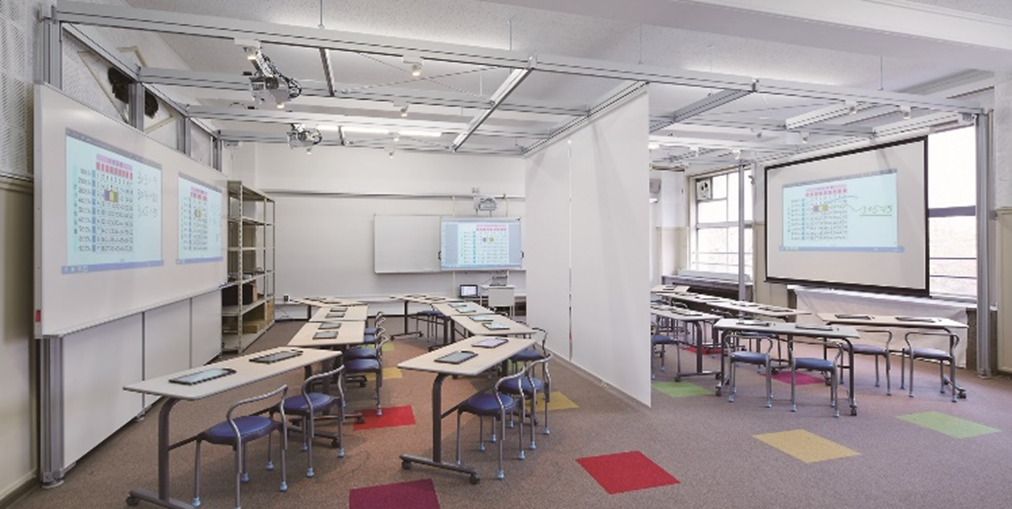
University of Tsukuba Elementary School "Future Class Room" 2013
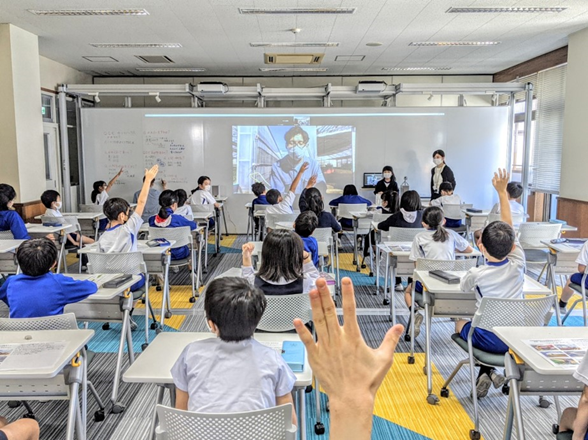
Takehaya Elementary School attached to Gakugei University "SUGOI Room" to be established in 2022
The concept of future classrooms has been a cornerstone of our company's efforts for many years. However, we firmly believe that the idea of creating conducive and comfortable learning spaces shouldn't be confined solely to educational institutions. Numerous companies can reap the benefits of adopting innovative communication interfaces. While we have introduced future classrooms to schools and universities, we have observed a significant interest from private firms aiming to implement them within their offices or corporate campuses. We're dedicating substantial efforts to establishing such environments and infrastructures.
Another facet of our business focuses on new applications. Over the past decade, we have developed cloud-based meeting room management systems for offices, known as Smart Rooms. Our pioneering efforts in this domain have yielded substantial results, positioning us as the market leader.
This system is continually enhanced to allow workers to use the meeting room management system on their smartphones. The system allows workers to reserve and personalize meeting rooms, as well as monitor meeting room reservations and availability to monitor office congestion. The software aggregates building data from users and contributes to its functionality.
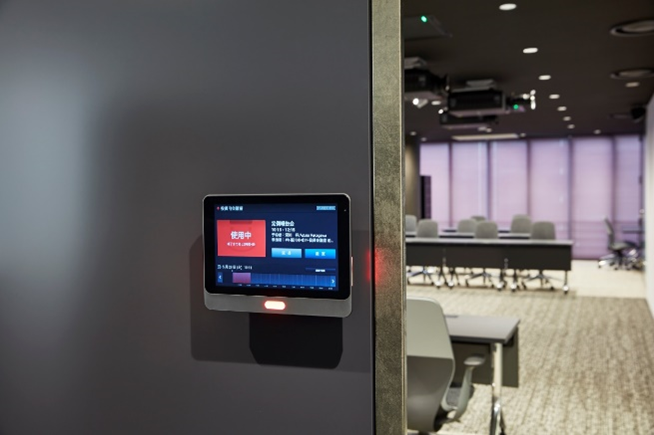
SmartRooms
In 2022, Uchida Yoko began full-scale provision of "SmartOfficeNavigator," which visualizes the whereabouts of employees who come to work and how their offices are being used.
Employees can now freely work where they want to work according to their jobs, including free-address, meeting rooms, and shared office space. This has created an obstacle in that it takes time to check whether employees who want to have a meeting are at the office and who is currently on which floor and where they are.
The SmartOfficeNavigator enables "all-in-hand" operation of employee whereabouts, meeting room usage, and congestion status based on WiFi data from the smartphones and laptop computers (PCs) used by all employees.
If an employee you want to find is in the company, you can immediately see where he or she is. The system visualizes the status of the person you are looking for and provides efficient methods and timing of contact.
In addition, data on the use of conference rooms and office areas is obtained from sensors that detect the degree of congestion and usage, as well as information from counting cameras. The analysis results can be used to significantly renew the conference room environment and improve operations. At the same time, consideration is given to the working environment within the building or office, such as temperature, humidity, and carbon dioxide concentration. A new function has been added that allows users to visualize the operating status of lighting and air conditioning using a smartphone, and to operate lighting, air conditioning, ventilation, and other building facilities.
Notable offices that have implemented this software include Mitsubishi Motors, ZEON Corporation, and Olympus Corporation.
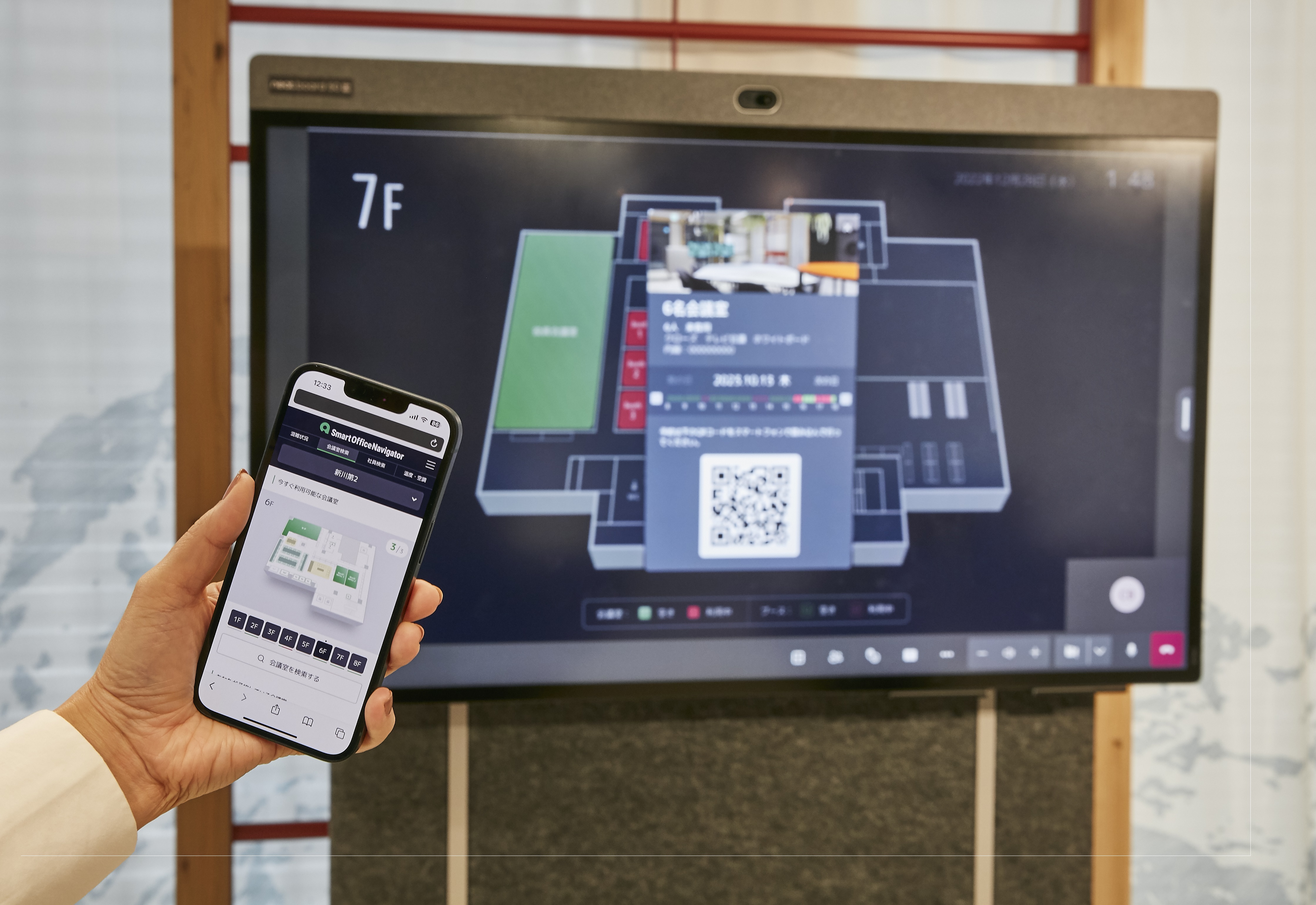
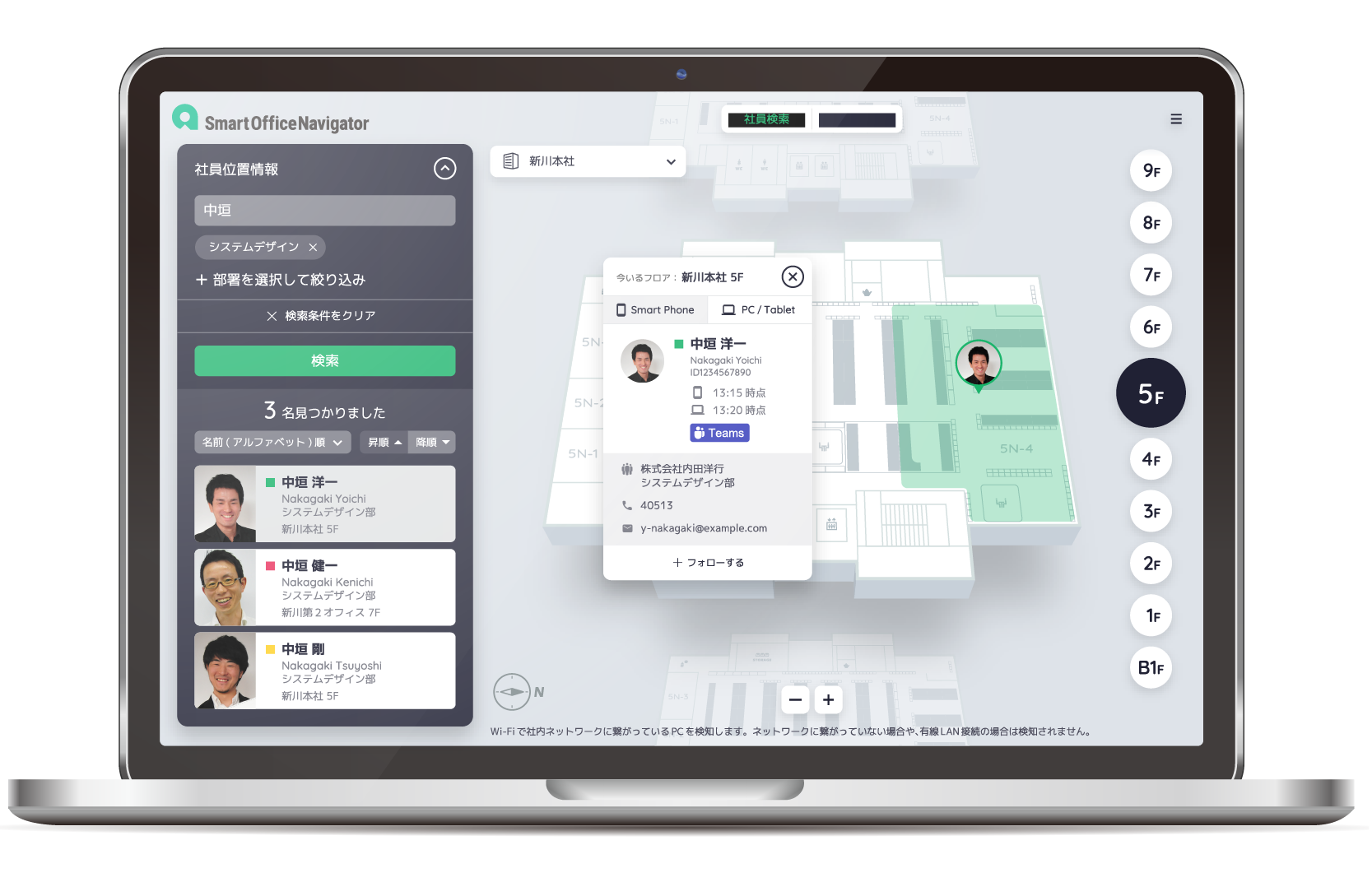
SmartOfficeNavigator
Another important initiative of ours is to create data bridges connecting schools and municipalities as well as companies.
One of the tools that emerged from this initiative is Mµgen, a DX promotion tool developed by the Uchida Yoko Group.
Specifically, it uses a dashboard of educational data to find children and students who are not improving academically despite the amount of learning they are doing, so that they can be supported in their studies. In addition, the project is also considering the possibility of estimating problems in the home environment, such as parents, based on situations where children are studying early in the morning or late at night, or are absent or tardy more often, and linking this to welfare. The study data will be used as a starting point to combine various data about one child and analyze them from multiple angles to help identify children in need of support.
It is necessary to start by linking and visualizing the information on residents and data in the field of welfare held by schools, boards of education, and each local government department, and there are solutions to problems that can be realized through this kind of cross-organizational linkage of data.
It has evolved into a preferred system for companies to manage and analyze their data. We are keen on facilitating the introduction of this tool, essentially forging a link between the learning and working environments. Uchida Yoko is committed to uniting and collaborating with customers for mutual gains—connecting customers, technology, and data. With this strategic approach, we aim to foster our company's growth in the foreseeable future, and by doing so, contribute significantly to Japan's transformation. While we may not be on the scale of tech giants like Google, Amazon, Facebook, and Apple (GAFA), we possess distinct strengths that we can leverage to become an indispensable pillar supporting Japan and beyond.
Interview conducted by Karune Walker & Sasha Lauture
0 COMMENTS